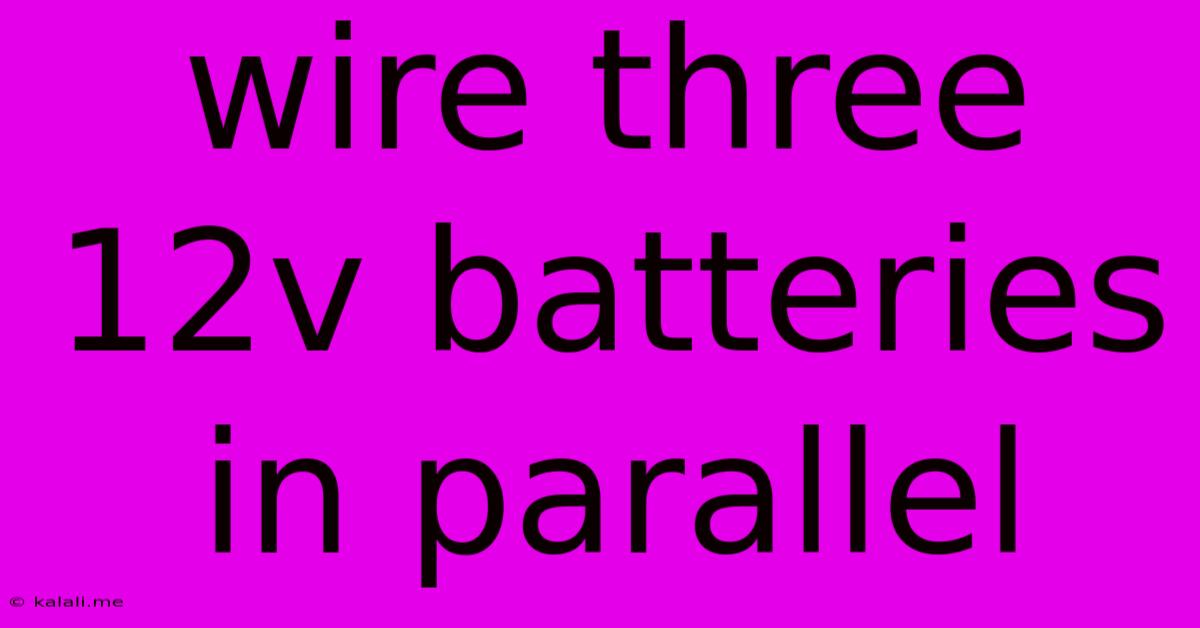Wire Three 12v Batteries In Parallel
Kalali
Jun 06, 2025 · 4 min read

Table of Contents
Wiring Three 12V Batteries in Parallel: A Comprehensive Guide
Connecting three 12V batteries in parallel increases your overall amperage capacity while maintaining the same voltage (12V). This configuration is ideal for applications requiring higher current draw, such as powering large amplifiers, multiple devices, or extending the runtime of your system. This guide will walk you through the process safely and efficiently, covering everything from necessary materials to crucial safety precautions.
Why Parallel Wiring?
Unlike series wiring, which adds voltages, parallel wiring adds amperage. This means you'll have more power available to your devices without increasing the voltage. This is essential when you need a sustained high current for extended periods, preventing your individual batteries from being overloaded. Think of it like having three separate water pipes merging into one larger pipe – the flow (amperage) increases, but the water pressure (voltage) remains the same.
Materials You'll Need:
- Three 12V Batteries: Ensure all batteries are of the same type, age, and state of charge (SOC) for optimal performance and to prevent premature wear. Different battery chemistries (e.g., lead-acid, lithium-ion) should never be paralleled.
- Battery Cables: Use heavy-gauge, appropriately sized battery cables to handle the increased current. The cable gauge should be sufficient for the maximum current draw of your system. A lower gauge number indicates a thicker, higher-current capacity cable. Consult a wire gauge chart to determine the right size for your application.
- Crimping Tool: A high-quality crimping tool is essential for creating secure, reliable connections. Poorly crimped connections can lead to overheating, sparking, and potential fire hazards.
- Ring Terminals: These attach the battery cables to the battery terminals securely. Ensure the ring terminals are the correct size for your battery cables and terminals.
- Insulation Tape or Heat Shrink Tubing: Use to insulate all connections and prevent short circuits.
- Multimeter: A multimeter is crucial for checking battery voltage and current before, during, and after the wiring process. It ensures the proper functioning of the parallel connection and identifies potential issues early on.
- Safety Glasses and Gloves: Always wear safety glasses and gloves when working with batteries and electrical connections.
Step-by-Step Wiring Process:
- Preparation: Begin by carefully cleaning all battery terminals with a wire brush to remove any corrosion or dirt. This ensures a clean and efficient connection.
- Attaching Ring Terminals: Crimp the ring terminals securely onto each end of your battery cables. Ensure the crimp is tight and the connection is strong.
- Connecting the Batteries: Connect one end of a battery cable to the positive (+) terminal of the first battery, using a ring terminal. Then, connect the other end of that same cable to the positive (+) terminal of the second battery. Repeat this process, connecting the positive terminals of all three batteries together with the same cable. This creates a positive bus.
- Creating the Negative Bus: Repeat step 3 for the negative (-) terminals of all three batteries, using a separate cable for the negative bus.
- Insulation: After connecting all terminals, thoroughly insulate all connections with either electrical tape or heat shrink tubing. This prevents accidental short circuits and ensures safety.
- Testing the Connection: Use a multimeter to check the voltage across the positive and negative buses. It should read approximately 12V. You should also verify there are no short circuits by checking for unusually high current readings.
- Connecting to Your Load: Connect the positive cable from your load to the positive bus and the negative cable from your load to the negative bus.
Important Safety Precautions:
- Never connect batteries of different voltages or chemistries in parallel.
- Always wear safety glasses and gloves.
- Ensure all connections are secure and properly insulated.
- Work in a well-ventilated area.
- Be aware of the potential for sparks and fire.
- Disconnect the batteries from the load before making any changes to the wiring.
Troubleshooting:
- Low Voltage: This indicates a problem with one or more of the batteries. Check each battery's voltage individually.
- High Current Drain: This could indicate a short circuit somewhere in your wiring. Carefully inspect all connections and insulation.
By carefully following these steps and safety precautions, you can successfully wire three 12V batteries in parallel, significantly increasing your system's power capacity for demanding applications. Remember to prioritize safety and utilize appropriate tools and materials for a reliable and long-lasting setup.
Latest Posts
Latest Posts
-
How Long Does It Take For Thinset To Dry
Jun 06, 2025
-
Blender Texture Paint Not Working On Some Faces
Jun 06, 2025
-
Can You Create Clipping Masks With Pngs
Jun 06, 2025
-
How To Remove Moss From Brick
Jun 06, 2025
-
2007 Honda Shadow Aero Gas Tank Capacity In Litres
Jun 06, 2025
Related Post
Thank you for visiting our website which covers about Wire Three 12v Batteries In Parallel . We hope the information provided has been useful to you. Feel free to contact us if you have any questions or need further assistance. See you next time and don't miss to bookmark.